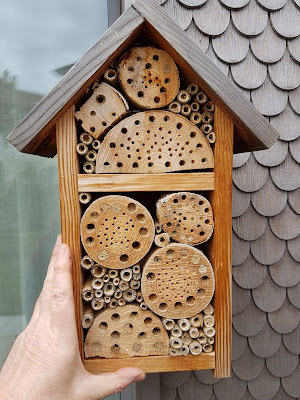And now, the first bees are emerging. Here two male Red Mason Bees (Osmia bicornis), with white hairy faces, seem to be looking at each other. Mason Bees like holes that are 8-12 mm in diameter, into which they will lay a row of eggs plugged with mud.

Friday, March 23, 2018
Mason bees
I have a small solitary bee nest at the back of my house in Basel.
And now, the first bees are emerging. Here two male Red Mason Bees (Osmia bicornis), with white hairy faces, seem to be looking at each other. Mason Bees like holes that are 8-12 mm in diameter, into which they will lay a row of eggs plugged with mud.
And now, the first bees are emerging. Here two male Red Mason Bees (Osmia bicornis), with white hairy faces, seem to be looking at each other. Mason Bees like holes that are 8-12 mm in diameter, into which they will lay a row of eggs plugged with mud.
Wednesday, March 21, 2018
Cum on feel the noize
It's only six kilometers, as the Stork flies, from my home near Lange Erlen Park in Basel to La Petite Camargue Alsacienne across the border in France.
It is part of the old flood plain of the Rhine - which has been channelled over the years for farming, fishing and shipping - and is a haven of marsh and meadow.
Looking over the marsh, it seems an oasis of calm.
I see I am not the only foreigner here. There are immigrants feeding on the foliage. Scottish Highland Cattle trudge through the mud - a tough breed that will eat tough plants, they have been introduced to maintain the water meadows.
An unwelcome grazer on the edge of the water - the Coypu. It was introduced from South America for the fur trade, and escapees bred and spread throughout France.
Egyptian Geese (Alopochen aegyptiaca), also brought in by man, have escaped to graze by the Rhine instead of the Nile.
But all is not calm. For it is the first day of Spring. All around me the air is filled with the activity and sounds of birds. In the isolated tall trees Cormorants, Grey Herons and Storks fly back and forth in their nest building. The Storks clatter their beaks.
In the surrounding woods and shrubs, it seems every bird is either carrying nesting material or singing - including small Wrens mousing through the reeds...
...and Nuthatches darting from tree to tree.
Overhead, a Sparrowhawk circles.
Across the marsh, on the outskirts of Basel, I can see an office tower block of my old company. I'm happier to be here in noisy nature, than there in the quiet corridors of industry.
Friday, March 2, 2018
UK is OK
A few days back in the UK. A scan of my sister's garden in the Chilterns, north-west of London, yielded eighteen species of birds. Of note, the Lesser Redpoll (Acanthus cabaret) - with its red breast and head spot - a new species for me, and a recent species for science (as it was previously considered as a browner sub-species of the Common Redpoll, A. flammea, now confined to Scandinavia). I thought this was a rare sighting so far south, but I met a couple of birders in Kent who had also seen them in their gardens. I also picked up the UK sub-species of the Long-tailed Tit (Aegithalos caudatus rosaceus) and Bullfinch (Pyrrhula pyrrhula pileata). Overhead eight Red Kites flew together, looking out for the food which the neighbours leave for them their gardens.
Eastwards to Kent, home of my friends John and Neil - and some birding on the snowy coast.
At the Swale Nature Reserve on the Isle of Sheppy (Sheep Island) there is a 'raptor watching' mound, raised above the reeds. I was told that at the end of the day I had a good chance of seeing Short-eared Owls hunting. I waited in minus temperatures, and was instead rewarded by a Merlin (Falco columbarius aesalon) flying by - my first ever clear view of a long-time 'bogey' bird. Not only that, it is my 500th bird in the Western Palearctic - something to celebrate!
As night began to fall, and I was near frozen, I drove out of the reserve. As I crawled along the ditches, scanning the reeds, something caught my eye. White, but not the snowy white of a gull - a more ghostly white. And past me gently floated an owl - a Barn Owl (Tyto alba). Next time I take a decent camera.
Eastwards to Kent, home of my friends John and Neil - and some birding on the snowy coast.
At the Swale Nature Reserve on the Isle of Sheppy (Sheep Island) there is a 'raptor watching' mound, raised above the reeds. I was told that at the end of the day I had a good chance of seeing Short-eared Owls hunting. I waited in minus temperatures, and was instead rewarded by a Merlin (Falco columbarius aesalon) flying by - my first ever clear view of a long-time 'bogey' bird. Not only that, it is my 500th bird in the Western Palearctic - something to celebrate!
As night began to fall, and I was near frozen, I drove out of the reserve. As I crawled along the ditches, scanning the reeds, something caught my eye. White, but not the snowy white of a gull - a more ghostly white. And past me gently floated an owl - a Barn Owl (Tyto alba). Next time I take a decent camera.
Subscribe to:
Comments (Atom)

















